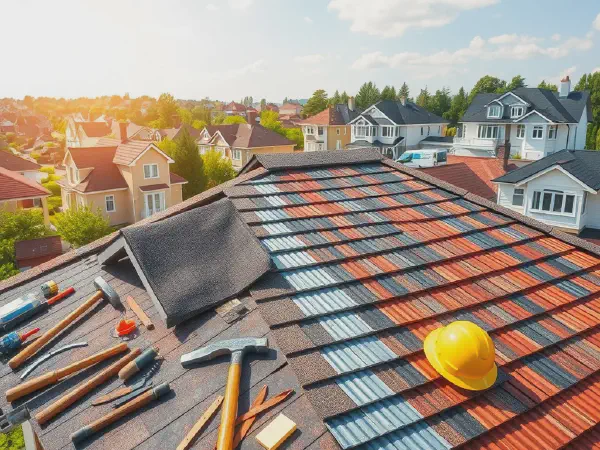Essential Guide to Roof Replacement: Key Insights and Tips

A Comprehensive Guide to Roof Replacement
Roof replacement is a significant investment for any homeowner, often necessitated by age, damage, or leaks. A well-timed roof replacement can enhance your home’s energy efficiency, protect your interiors, and increase your property value. Understanding the importance of roof replacement and staying informed about the process can help ensure you make the right decisions for your home.
Choosing to undertake a roof replacement involves various critical factors including the state of your current roof, your budget, and the materials you prefer. It's important to recognize that not all roofing issues require a full replacement; sometimes a repair can suffice. However, knowing when to opt for a complete roof replacement is essential to maintaining the integrity of your home.
The roof replacement process can seem overwhelming, but it can be broken down into manageable steps. From assessing the need for a replacement to selecting materials and hiring a contractor, understanding each stage can alleviate stress and help ensure a successful roofing project. Proper preparation will lead to a smooth installation, avoiding complications and costly delays.
Many homeowners in need of roof restoration clyde choose professionals to ensure long-lasting results and curb appeal.
One of the most significant aspects of roof replacement is its financial implications. Homeowners should be aware of the costs associated with roof replacement, how to budget for it, and available financing options. Investing in a new roof not only protects your home but can also yield long-term savings through increased energy efficiency and reduced repair costs.
Finally, maintaining your new roof after replacement is crucial for longevity and performance. Routine inspections and maintenance can extend the life of your roof, preventing issues that can arise from neglect. Understanding best practices for roof care will ensure your investment truly stands the test of time.
Investing in a quality metal roof replacement in melbourne can significantly enhance your home's value and durability.
Understanding Roof Replacement
Roof replacement is the process of removing an existing roof and replacing it with a new one. This is typically necessary when the roof is beyond repair, damaged structurally, or has reached the end of its lifespan. Factors such as weather, material type, and maintenance history influence the need for replacement. A roof should be replaced if it has significant leaks, multiple layers of shingles, or visible sagging.
Several signs indicate you may need a roof replacement. Common indicators include extensive water damage inside your home, missing shingles, curled or buckled shingles, and granules from asphalt shingles accumulating in your gutters. If you notice daylight streaming through your roof boards or experience a higher-than-usual energy bill, it could be time for a replacement.
The primary difference between roof repair and replacement is the extent of the damage. Roof repair is suitable for minor issues, such as a small leak or a few missing shingles. In contrast, a roof replacement is necessary when the damage is extensive, and repairs cannot guarantee the roof's structural integrity. Consulting a roofing professional can provide clarity on whether a repair or replacement is appropriate in your situation.
Choosing the Right Materials for Roof Replacement
When it comes to roof replacement, selecting the right materials is crucial. Popular roofing materials include asphalt shingles, metal roofs, wood shakes, and tile roofs. Each material has its benefits, like the affordability and ease of installation of asphalt shingles or the longevity and durability of metal roofs. Your choice should reflect your budget, the climate in your area, and your home's architectural style.
Cost comparison is essential when choosing roofing materials. Asphalt shingles are often the most affordable, while metal roofs and tile roofs tend to have higher upfront costs but can save money over time due to their durability and lifespan. It's advisable to weigh the initial cost against potential long-term savings when selecting roofing materials for replacement.
Eco-friendly roofing options are becoming increasingly popular among homeowners. Materials such as recycled metal, bamboo, and solar tiles not only reduce environmental impact but can also lead to increased energy efficiency and potential tax benefits. Researching sustainable roofing choices can provide options that align with your environmental values while protecting your home.
The Roof Replacement Process
The roof replacement process generally involves several steps. First, a roofing contractor will conduct an inspection to assess the condition of your current roof and determine the extent of work needed. After confirming a replacement is necessary, the contractor will select the appropriate materials and create a timeline for the project. The old roof will then be removed, and the new roofing materials will be installed following proper safety and building regulations.
The duration of a roof replacement project varies based on the size and complexity of the roof, as well as weather conditions. On average, a full roof replacement can take anywhere from a few days to a couple of weeks. Factors such as the roofing materials chosen and the availability of labor can also impact the timeline for completion.
Warranties and insurance play a vital role in the roof replacement process. Many roofing materials come with warranties that can range from several years to a lifetime, while contractors may also offer labor warranties. Understanding these warranties can protect your investment. It's also essential to ensure that both you and your roofing contractor have appropriate insurance to cover potential damages during the installation process.
Financial Aspects of Roof Replacement
Several factors contribute to the cost of roof replacement, including the size of your roof, the type of materials selected, and labor costs. Additionally, factors such as roof accessibility, existing roof layers, and local building codes can affect the final cost. Homeowners should budget accordingly and consider potential hidden costs, such as necessary repairs to the roof deck or insulation.
Budgeting for roof replacement is crucial to avoid unexpected expenses. Homeowners should create a detailed budget, factoring in the costs of materials, labor, permits, and any potential extra expenses that may arise during the project. It is wise to set aside a contingency fund of around 10-20% of your total budget to cover unforeseen issues.
Financing options for roof replacement can ease the financial burden. Homeowners may consider using savings, taking out a home equity loan, or applying for financing through the roofing contractor. Some lenders offer specialized loans for home improvements. It's essential to explore different financing solutions to find one that best fits your financial situation.
Hiring a Roofing Contractor
Choosing the right roofing contractor is critical to ensuring a successful roof replacement. Homeowners should conduct thorough research to find reputable contractors in their area. Checking online reviews, obtaining references, and ensuring the contractor has the necessary licenses and insurance can facilitate this process. Interviews and consultations can further help to find the best fit for your project.
Before hiring a roofing contractor, it's important to ask specific questions to gauge their expertise and reliability. Inquire about their experience, past projects, and warranties offered. Ask for written estimates that include itemized costs, timelines for completion, and what to expect during the installation process. A reputable contractor should be transparent and willing to address your concerns.
Understanding contractor estimates is essential for homeowners. A detailed estimate should outline all projected costs, including materials, labor, and potential additional expenses. Compare multiple estimates to ensure you’re getting about fair pricing. Be cautious of unusually low quotes, as they may indicate subpar materials or workmanship.
Maintaining Your New Roof
Proper maintenance is key to extending the life of your new roof post-replacement. Regular inspections, cleaning gutters, and removing debris are vital to preventing issues such as leaks or water damage. Homeowners should schedule seasonal inspections to assess their roof’s condition and address any minor problems before they escalate.
Common issues to look out for include signs of wear and tear, water stains on interior ceilings, and missing shingles. Regularly check for signs of mold, lichen growth, or rust, particularly in metal roofs. Addressing these issues promptly will help maintain the integrity of your new roof and prevent costly repairs in the future.
Creating a seasonal maintenance checklist can help homeowners keep track of essential roof care tasks. This should include inspections after severe weather, cleaning gutters, checking for damaged shingles, and ensuring vents and chimneys are clear. Following a regular maintenance schedule will greatly enhance the longevity and performance of your new roof.
